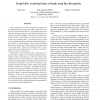618 search results - page 97 / 124 » Computational Models of Natural Language Argument |
ICCV
2007
IEEE
14 years 10 months ago
2007
IEEE
Topic models have recently emerged as powerful tools for modeling topical trends in documents. Often the resulting topics are broad and generic, associating large groups of people...
ICMI
2009
Springer
14 years 3 months ago
2009
Springer
Pointing combined with verbal referring is one of the most paradigmatic human multimodal behaviours. The aim of this paper is foundational: to uncover the central notions that are...
HCI
2009
13 years 6 months ago
2009
Abstract. Although older people are an important user group for smart environments, there has been relatively little work on adapting natural language interfaces to their requireme...
JMLR
2012
11 years 11 months ago
2012
Often when modeling structured domains, it is desirable to leverage information that is not naturally expressed as simply a label. Examples include knowledge about the evaluation ...
HLPPP
1991
13 years 12 months ago
1991
Swarm is a computational model which extends the UNITY model in three important ways: (1) UNITY’s fixed set of variables is replaced by an unbounded set of tuples which are add...

